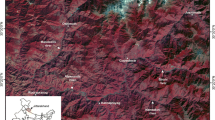Abstract
Landslide mapping is essential for effective watershed management. In Taiwan, a typhoon or earthquake event can trigger hundreds, even thousands, of shallow landslides in mountainous watersheds. Thus, improving the efficiency of landslide mapping by means of remote sensing techniques is an important issue. This study proposes a new method that uses concurrent aerial laser scanning (ALS) data and color ortho-imagery as input data: the topographic indices of slope, surface roughness, and object height model can be derived from the ALS data and the Green–Red Vegetation Index from the ortho-images. The method first uses these topographic and spectral indices in a global, semi-automatic algorithm to separate landslide from non-landslide pixels. It then offers a region growing tool and a 3D Eraser/Painter to edit detected landslides locally. These global and local operations are designed with a user interface, which is intuitive and user-friendly. Results from four test sites in a mountainous watershed prove that the method is easy, accurate, and suitable for landslide mapping in Taiwan.







Similar content being viewed by others
References
Arattano M, Marchi L (2008) Systems and sensors for debris-flow monitoring and warning. Sensors 8:2436–2452
Ardizzone F, Cardinali M, Galli M, Guzzetti F, Reichenbach P (2007) Identification and mapping of recent rainfall-induced landslides using elevation data collected by airborne Lidar. Nat Hazards Earth Syst Sci 7:637–650
Behan A, Maas H-g, Vosselman G (2000) Steps towards quality improvement of airborne laser scanner data. In: Proceedings of the 26th annual conference of the remote sensing society, Leicester, September, 2000, pp 12–14
Bishop YMM, Fienberg SE, Holland PW (1975) Discrete multivariate analysis: theory and practice. MIT Press ISBN 978-0262021135 MR381130
Borghuis M, Chang K, Lee HY (2007) Comparison between automated and manual mapping of typhoon-triggered landslides from SPOT-5 imagery. Int J Remote Sens 28(8):1843–1856
Chang KT, Chiang SH, Hsu ML (2007) Modeling typhoon- and earthquake-induced landslides in a mountainous watershed using logistic regression. Geomorphology 89:335–347
Chang KT, Chiang SH, Lei F (2008) Analysing the relationship between typhoon-triggered landslides and critical rainfall conditions. Earth Surf Proc Land 33:1261–1271
Cheng JD, Huang YC, Wu HL, Yeh JL, Chang CH (2005) Hydrometeorological and landuse attributes of debris flows and debris floods during typhoon Toraji, July 29–30, 2001 in central Taiwan. J Hydrol 306:161–173
Chung CJF, Fabbri AG (1993) The representation of geoscience information for data integration. Nat Resour Res 2:122–139
Dadson SJ, Hovius N, Chen H, Dade WB, Lin JC, Hsu ML, Lin CW, Horng MJ, Chen TC, Milliman J et al (2004) Earthquake-triggered increase in sediment delivery from an active mountain belt. Geology 32:733
Delacourt C, Raucoules D, Le Mouélic S, Carnec C, Feurer D, Allemand P, Cruchet M (2009) Observation of a large landslide on La Reunion Island using differential SAR interferometry (JERS and Radarsat) and correlation of optical (Spot5 and Aerial) images. Sensors 9:616–630
Donati L, Turrini MC (2002) An objective method to rank the importance of the factors predisposing to landslides with the GIS methodology: application to an area of the Apennines (Valnerina; Perugia, Italy). Eng Geol 63:277–289
Glassner A (1989) An introduction to ray tracing. Academic Press Limited, New York
Highland LM, Bobrowsky P (2008) The landslide handbook—a guide to understanding landslides-reston, Virginia, US Geological Survey Circular 1325. United States Geological Survey
Jaboyedoff M, Oppikofer T, Abellán A, Derron M-H, Loye A, Metzger R, Pedrazzini A (2010) Use of LIDAR in landslide investigations: a review. Nat Hazards. doi:10.1007/s11069-010-9634-2
Kohavi R, Provost F (1998) Glossary of terms. Mach Learn 30:271–274
Lemp D, Weidner U (2005) Improvements of roof surface classification using hyperspectral and laser scanning data. Proceedings URBAN 2005, Arizona, CD-ROM
Lin ML, Jeng FS (2000) Characteristics of hazards induced by extremely heavy rainfall in Central Taiwan–Typhoon Herb. Eng Geol 58:191–207
Lin CW, Liu SH, Lee SY, Liu CC (2006) Impacts of the Chi–Chi earthquake on subsequent rainfall-induced landslides in central Taiwan. Eng Geol 86:87–101
Metternicht G, Hurni L, Gogu R (2005) Remote sensing of landslides: an analysis of the potential contribution to geo-spatial systems for hazard assessment in mountainous environments. Remote Sens Environ 98:284–303
Mikos M, Fazarinc R, Ribicic M (2006) Sediment production and delivery from recent large landslides and earthquake-induced rock falls in the Upper Soca River Valley, Slovenia. Eng Geol 86:198–210
Motohka T, Nasahara KN, Oguma H, Tsuchida S (2010) Applicability of green-red vegetation index for remote sensing of vegetation phenology. Remote Sens 2:2369–2387. doi:10.3390/rs2102369
Parker JR (1997) Algorithms for image processing and computer vision. Wiley Computer, New York
Rau JY, Chen LC, Liu JK, Wu TH (2007) Dynamics monitoring and disaster assessment for watershed management using time-series satellite images. IEEE Trans Geosci Remote Sens 45:1641–1649
Schulz W (2007) Landslide susceptibility revealed by LIDAR imagery and historical records, Seattle, Washington. Eng Geol 89:67–87. doi:10.1016/j.enggeo.2006.09.019
Tucker CJ (1979) Red and photographic infrared linear combinations for monitoring vegetation. Remote Sens Environ 8(2):127–150. doi:10.1016/0034-4257(79)90013-0
Varnes DJ (1978) Slope movement types and processes. In: Schuster RL, Krizek RJ (eds) Special Report 176: Landslides: analysis and control. Transportation and road research board, National Academy of Science, Washington D.C., pp 11–33
Acknowledgments
The work was supported by the Council of Agricultural, Executive Yuen, Taiwan, R.O.C. The authors would also like to acknowledge the advice of Prof. L.C. Chen, Center for Space and Remote Sensing Research, National Central University, Taiwan, R.O.C.
Author information
Authors and Affiliations
Corresponding author
Rights and permissions
About this article
Cite this article
Rau, JY., Chang, KT., Shao, YC. et al. Semi-automatic shallow landslide detection by the integration of airborne imagery and laser scanning data. Nat Hazards 61, 469–480 (2012). https://doi.org/10.1007/s11069-011-9929-y
Received:
Accepted:
Published:
Issue Date:
DOI: https://doi.org/10.1007/s11069-011-9929-y




